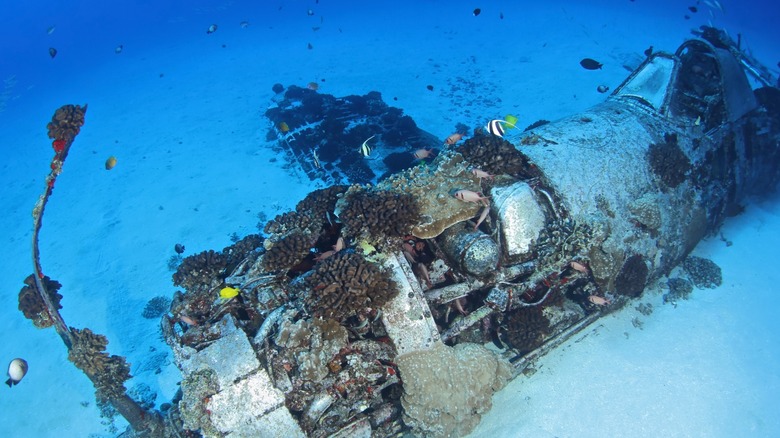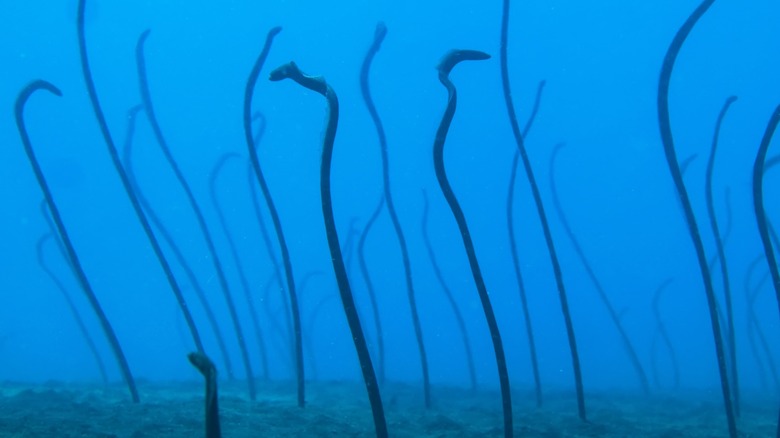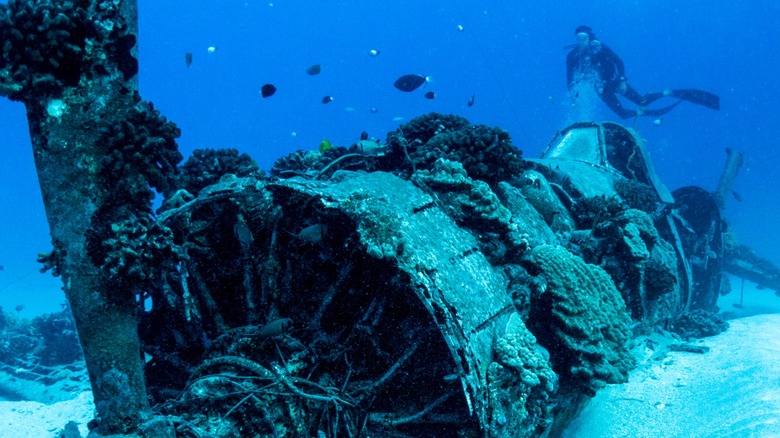One Of Hawaii's 'Premier Wreck' Sites Is A Diver's Playground With Unique Eels And Clear Visibility
O'ahu, one of eight spectacular volcanic islands that make up the Hawaiian archipelago, is an adventure-lover's paradise, with world-class surf spots, mountain-biking and hiking trails, and dive sites. The "Heart of Hawai'i" is also home to incredible beaches, including Lanikai Beach, a pristine gem that is consistently voted one of the world's best.
Additionally, O'ahu holds the state's capital, Honolulu, which was named the world's safest city to visit in 2024. This is where you can find Pearl Harbor, the site of the infamous attack by the Imperial Japanese Navy, which led to the U.S. entering World War II. Because of this history, the island has many war memorials, ruins, and museums honoring those who lost their lives that day and educating visitors about the war.
One particularly unique WWII site is the underwater Corsair wreck. Luckily, the only casualty of the incident was the plane, which went down during a standard ferry flight a few months before the end of the war. On April 17, 1945, 2nd Lt. William H. Holden was meant to pilot the Corsair F4U-1A plane from the Molokai Airfield near Maui to Ewa Airfield on Oahu. However, things didn't go according to plan. About 20 minutes into the flight, his engine failed and he ditched the aircraft just off the southeast shore of O'ahu. Holden was rescued, mostly unscathed, but the plane was less fortunate. It sank to the ocean floor about 3 miles from the Hawai'i Kai marina in Maunalua Bay, upright and mostly intact on the sandy bottom. The aircraft is recognizable due to its bent propeller blade and open cockpit, and — with the exception of one wing submerged in the sand — the entire plane is visible. Today, it remains one of the state's premier wreck sites, a playground for divers worldwide to explore.
Biodiversity at the Corsair wreck
While the Corsair wreckage has become a WWII time capsule, the plane has also bred new life through an impressive surge of biodiversity. The Corsair, a fighter plane once used for combat missions, is now a safe haven for a wide variety of marine life. Before the plane's arrival from above, there was only sand here and nothing to attract animals big or small. But, just like natural structures, manmade objects like a plane's wreckage can allow for coral reef organisms to attach themselves and grow, bringing new life to what would otherwise be a barren seascape.
Beside one of the plane's wings is an otherworldly field of garden eels, stationed in their burrows and undulating with the current as they feed on plankton floating by. Wrecks create an obstacle that currents need to move around, which pushes swarms of plankton up to the waiting creatures. Larger eels, like morays, can also be found in the cockpit and fuselage of the plane — so be wary of poking around the site fingers-first, as morays have a mean bite!
Swimming in and out of the fuselage — and in the general area — is a wide variety of fish species that call the Hawaiian Pacific home. These include frogfish, goat fish, jacks, butterfly fish, soldier fish, snappers, and squirrelfish. Hawaiian stingrays and octopi can be seen on occasion; and if you're extremely lucky, a Galapagos shark or a humpback whale may pass by in the winter. Many of the small species in this mini-ecosystem use the plane's structure to hide from larger predators, while feeding on plankton or digging up worms and crustaceans from the sandy bottom.
What to expect at the Corsair wreck
During your dive, you'll have 80 to 100 feet of visibility in these crystal-clear waters. At a depth of around 105 feet, the wreck site is only accessible to certified scuba divers. An Open Water Diver certification allows divers to view the plane from above, from a depth of 60 feet, and an Advanced Open Water Diver certification is required to go down to the level of the plane. This site is classified as an Advanced Boat Dive (intermediate to advanced level) due to its conditions, and it isn't suitable for inexperienced divers. The area has very strong and unpredictable currents, and an anchor line is needed for the descent. Upon reaching the bottom, divers must swim about 30 feet to access the wreck. Because of the depth of the site, the surrounding currents, and the amount of swimming required, bottom times will be short (around 14 to 16 minutes), and a safety stop is recommended.
A guide is also required for this site, which can only be reached by boat. Dives can be booked through one of the many local operators, including Reef Pirates and Aaron's Dive Shop. While the ride is short (around 15 minutes), the waves are bumpy, so if you are prone to seasickness, take a pill in advance to avoid nausea. Prices for the trip will vary depending on the operator, the number of dives, and other factors. But as of the time of writing, companies running half-day trips (typically with two dives: the wreck site and a shallow reef) were charging between $145 to $165 (not including taxes, tips, and equipment rentals). Note that you cannot fly within 18 hours of your last dive due to a risk of decompression sickness, also known as "the bends."
If you're a certified diver planning a trip to O'ahu, this WWII relic hosting a plethora of Hawaiian marine life is certainly an adventure well worth the visit. While you're planning your itinerary, check out these other amazing experiences unique to O'ahu.


